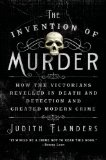Summary | Excerpt | Reviews | Beyond the Book | Readalikes | Genres & Themes | Author Bio

How the Victorians Revelled in Death and Detection and Created Modern Crime
by Judith Flanders
De Quincey then takes the story of the Marr and Williamson murders and himself turns them into art. The main figures are given psychological depth, and a motive is imagined. Most importantly, Williams is turned, as one literary critic observes, into 'a sort of Miltonic, ruined God', with a glamorized physical description to match his inward corruption of spirit. A sandy, undistinguished-looking man in life, in art Williams has a 'bloodless, ghastly pallor', and hair of 'the most extraordinary and vivid colour … something between an orange and a lemon colour'. His clothes, too, undergo a metamorphosis. He no longer wears the rough dress of a sailor. Instead de Quincey imagines a dandified being, dressing for an evening's slaughter in black silk stockings and pumps and with a long blue coat of 'the very finest cloth … richly lined in silk'. The murderer is now more vampire than cash-strapped sailor, more great actor than street thug.
In reality, there were few of de Quincey's type of murderer. Yet, as his imaginary lecturer knows, 'the world in general … are very bloody-minded; and all they want in a murder is a copious effusion of blood'. How this desire was transformed over the nineteenth century, and how it, in turn, transformed that century, is my subject.
From Invention of Murder by Judith Flanders. Copyright © 2013 by the author and reprinted by permission of St. Martin's Press, LLC
Your guide toexceptional books
BookBrowse seeks out and recommends the best in contemporary fiction and nonfiction—books that not only engage and entertain but also deepen our understanding of ourselves and the world around us.